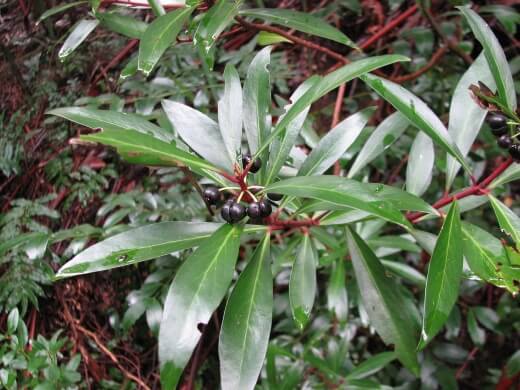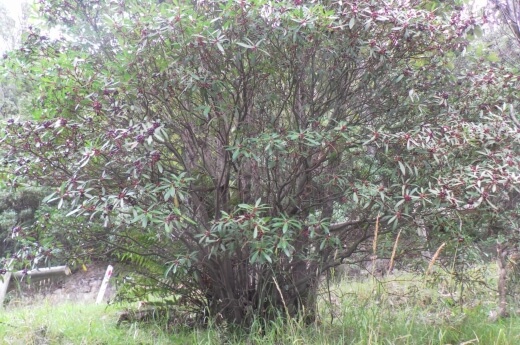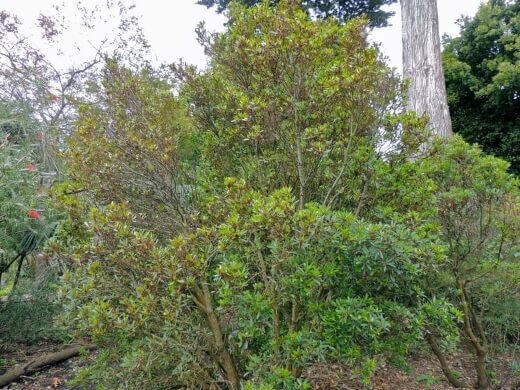If you’re a keen forager, or just love fresh ingredients straight from the garden, the Australian native flora has a lot to offer. Tasmanian Pepperberry is one of the most exciting ingredients to grow, with a flavour that only ever reaches its full potential on our native soils.
Native Mountain Peppers, or Tasmanian Pepperberry, are super simple to grow, but you’ll need to find a reliably cool spot in the garden if you want the best from them.
Their fruity flavour has the kick of Sichuan pepper and the aromatics of ginger and fresh cinnamon, making them ideal for any Australian garden.
More...
Family: | Winteraceae |
|---|---|
Genus: | Tasmannia (syn. Drimys) |
Species: | T. lanceolata |
Common Names: | Tasmanian pepperberry, Mountain pepper, Native pepper |
Location: | Outdoor |
Type: | Evergreen shrub |
Growth: | 5-8m tall, usually pruned to 2-3m |
Sun requirements: | Semi-shade |
Foliage Colour: | Dark green (edible) |
Flower Colour: | White |
Flowering: | Summer |
Fruit: | Edible dark berries in autumn |
Maintenance level: | Low |
Poisonous for pets: | Non-toxic to pets |
What is Pepperberry?

Source: en.wikipedia.org
Pepperberry isn’t related to bell peppers or the spice in any way, but carries a similar flavour profile, with much more of an earthy sweetness.
There are dozens of Mediterranean herbs, and Asian spices that grow well in Australia, but like most plants, they prefer their native spaces and perform best there.
Tasmanian pepperberry is no different. Developing a rich, fruity flavour that’s accompanied by notes of hot, fresh, cinnamon when dried, and a gentle gingery kick, there is nothing quite like adding dried pepperberries into flavour rubs for BBQs.
Pepperberries’ Natural Habitat
Pepperberry is a woody shrub, native to Tasmania, New Zealand, and cooler parts of Australia. They can cope with full sun and full exposure but are actually quite delicate plants, despite their hardy appearance.
Like many native bush tucker plants, pepperberry needs both male and female plants to be present as they cannot self-pollinate.
If you intend to grow pepperberry at home for harvest, you’ll need two plants as a minimum, but we’d always suggest three as young plants are difficult to sex before they are in flower.
How to Grow Tasmanian Pepperberry
Mountain pepper grows best in moist but well-drained soil with plenty of organic matter. They don’t like sitting in boggy conditions but hate drying out completely too, so will need a little more attention than most garden plants through the summer months.
Below, we’ve got a step-by-step guide to help you find the best place to plant pepperberry shrubs in your garden.

Source: mystastrious.com.au
When to Plant Tasmanian Pepperberry
Peppery berries are best planted in spring or early summer when they have time to establish and a full growing season ahead of them. If you do plant them later in the year, make sure to water their roots thoroughly and mulch over the top to lock in moisture.


Get Your Free Guide:
Master Growing Australian Natives eBook
A Must Have Complete Guide for Every Australian Garden
Get Your Free Guide:
Master Growing Australian Natives eBook
A Must Have Complete Guide for Every Australian Garden
Soil / Drainage
Young pepperberries root fairly quickly and will establish well in their first year, but you’ll need to dig a hole at least twice the size of the root ball so their roots have free ground to grow into.
Once you’ve dug your hole, loosen the base with a garden fork, and then place the plant so its base is level with the soil surface. Mix any decent garden compost into the planting hole then water them thoroughly, followed by a mulch of compost or bark chip to help retain water.
Find out more about mulches, its types, and when to use them here.
Light Preference
Pepperberry prefers part shade but will cope with full sun in cooler parts of the country. If you have dappled shade, or a sheltered wall to plant against, your pepperberry will thrive.
Part of the reason for shelter is that afternoon sun in Australia and even Tasmania can dry out the soil too quickly. Their sturdy leaves don’t hold water well, so they need some protection from direct light to regulate their water.
Temperature
Pepperberry grows best in summers between 25-30°C and can survive freezing temperatures. If summer temperatures drop below 16C they are unlikely to fruit.
Watering Mountain Peppers
Pepperberry can sound complicated to water, but the reality is that you’re trying to replicate nature in the garden. These hardy shrubs will cope in natural conditions but might need a little help through summer droughts.
Mountain peppers like moist soil, but need to dry out slightly between watering. If there is a particularly hot summer ahead, water deeply once a week.
Do not overwater them, and if you’ve got tap timers or irrigation set up you’ll need to make sure your pepperberries are off that system to avoid accidentally waterlogging their roots.
Pollinating Tasmannia lanceolata
Pepperberries need both male and female plants to set fruit. This means that if you have just one pepperberry you won’t get berries.
Good garden centres will sell mountain pepper with male or female labels, but young plants can be hard to sex, so aim to have at least two or three plants in your garden to ensure pollination.
How to tell if a pepperberry is male or female
If you buy a pepperberry flower, the male and female flowers have different functions. The male plants won’t fruit, but their flowers are much larger to attract insects and pollinators.
Male pepperberry flowers are bigger, with more petals, and bushy centres. Female flowers are scented but discrete, with a crisper white petal and red sepals at their base.
How to Grow Pepperberries in Containers
To grow pepperberry in pots, simply fill the container with a mix of compost, grit, and garden soil. Pepperberry grows best in the ground, but can be grown in containers in smaller gardens, and clipped regularly to maintain a more manageable size.
They can reach up to 8m tall in the wild but are best pruned to around 1-2m tall in containers to reduce strain on their roots and make harvesting easier.
Propagating Tasmanian Pepperberry
Pepperberry is quite an easy native plant to propagate from cuttings or from seed, but you’ll need fresh seeds and fresh cuttings to do so.
If you’re used to propagating house plants and succulents, you’ll be aware that many plants like to callous before they root. Pepperberry does not.
Follow our guide below for flawless propagation of pepperberry plants every time:

Source: yarraranges.vic.gov.au
Growing Pepperberry from Seed
Propagating pepperberry seeds is challenging, and is best done from fresh seeds. Pepperberry seeds are viable for around 24 hours after they are removed from the tree, and quickly dry or split.
If you find dried pepperberry seeds, they are very unlikely to germinate.
Tools
- Seed compost
- 9cm pots
Method
- Take fresh seeds from the plant, and use them within 24 hours
- Fill 9cm pots with seed compost, and sow 2-3 pepperberry seeds in each pot
- Water them well until water runs through the bottom of the pot
- Leave in a warm, bright spot in the garden, exposed to the elements
- Water only when the soil dries out
- Germination takes around 4-6 weeks in late summer or autumn
- If all seeds germinate, remove all but the strongest seedling from each pot
- Care as you would with any young plant, with regular watering, and move to dappled shade after true leaves form
Note: While germination is difficult from old seeds, it is possible. Soak dried pepperberry seeds in lukewarm water overnight and sow a dozen seeds into each pot.
Germination is unlikely but possible so be patient, and keep the soil moist and warm.
Propagating Pepperberry from Cuttings
Take tip cuttings from pepperberry plants in late autumn after berries have ripened. The tips should be young, fresh growth from this year, and be around 12-15cm long.
Any new growth at this stage in the year will be fine to use, as it won’t be setting flowers, and will be beyond fruiting.
Tools
- Bypass secateurs - Get your bypass secateurs here.
- Seed compost and perlite (50:50)
- 9cm pots
Method
- Cuttings need to be taken fresh and dry out quickly, so prepare everything first
- Fill 9cm pots with a 50:50 mix of seed compost and perlite
- Cut 12-15cm of new growth from the tip of a young stem
- Remove all but the top leaves
- Cut the base of the cutting just below the lowest node (where roots will form)
- Make a small hose in the compost at the corners of the pot
- Drop 3-4 cuttings in per pot
- Water well
- Cover with a plastic bag to conserve moisture
- Keep in a warm shaded spot through autumn and winter, and water if the soil dries out completely
- Young plants can be separated in spring and potted into individual pots
Pepperberry Care Tips
Pepperberries are native, woody shrubs, and need very little care once they are established, but there are some ways to improve your yield with organic fertilisers and a regular mulch.

Source: davesgarden.com
Mulching Pepperberries
Pepperberry is hardy and do not need protection from frost, but in particularly warm regions, a spring mulch will help to protect their roots from baking summer temperatures and reduce moisture loss from the soil.
You can use anything for this, but compost and rotted manure will also act as a fertiliser which worms and soil life will dig down to the roots for you.
What Fertiliser to Use
Mulching is the best way to fertilise mountain peppers, but raised beds and borders can often get overfilled by regular mulching, so you can use a simple slow-release shrub fertiliser like chicken manure or Osmocote controlled release fertiliser for native plants which feeds the plant throughout summer with a single application.
Repotting
Tasmanian pepperberry grown in containers will need repotting every three years. You can either prune the roots back and change the compost to keep them in the same pot, and limit their size, or move them into a larger pot with new compost.
Either way, new compost is a must as they will have used up all the nutrients available to them over 2-3 years and will need some fresh goodness.
Pruning Tasmannia lanceolata
Pepperberry can grow up to 8m tall in the wild quite easily, but with competition from other plants, and regular pruning, they rarely reach over 5m in gardens.
Their fruits develop on the previous years’ growth, so pruning them back right after harvest encourages fresh autumn growth that will flower and fruit next year.
You can prune pepperberry hard in late summer or early autumn to encourage new shoots, or prune back one-third of the plant to the base each year, providing fresh growth at a manageable height.
Refer to our buying guide for the best pruning shears for your task.
Pepperberry Bush Tucker Guide

Source: nativeplantproject.com.au
How to Harvest Pepperberry
Pepperberry are easy to harvest, but knowing when they are ripe is important. Like any berry, they will pull or shake from the plant when they are ready for harvest.
When they are ripe, they will have two, plump, lobed wides to each fruit, and will have turned to a rich black with just a hint of their red colouring left.
Uses for Pepperberry
Once harvested, you can use pepperberries fresh, or dry them in the sun for a few days, then store them in airtight containers for up to a year.
Storing and Using Pepperberry
Pepperberries are the most sought-after part of the plant, with a beautiful aroma and tantalising flavour that can’t be replicated with other herbs and spices.
To prepare them from storage, dry them in the oven on a low temperature for 45 minutes, or leave them on a wire mesh rack in the sun for a few days.
Once the berries have lost most of their moisture content, pop them into a sterilised glass jar and keep them cool and dry. You can use them fresh, or grind them like peppercorns into food.
Preparing and Storing Mountain Pepper Leaves
As well as the berries, the leaves of mountain pepper are edible too and store for up to 6 months in an air-tight container. Simply dry them on a windowsill for a few days until they turn crunchy and brittle, then use them to make a delicious fragrant tea.
Common Pepperberry Pests and Diseases
Pepperberry plants have very few pests thanks to their aromatic leaves which deter most insects, and pungently flavoured berries that most wildlife will steer clear of.
That makes them an excellent choice for any garden and can actually help to reduce pests on nearby plants too. The only real problem they suffer from is root rot.
Pepperberry root rot is usually caused by overwatering, or the presence of Phytophthora, a fungal plant pathogen that can affect the foliage and roots of trees and shrubs in any garden.
If you suspect root rot (usual signs are yellowing leaves or dry top growth paired with damp soil), repot or dig up your plant, and check the roots.
There are fungal soil treatments you can add to water, but they can damage wildlife and soil health, so the best option is to reduce watering and allow the plant to dry out. It will recover next year and the hot, dry conditions will kill most fungal spores present.
Pepperberry Frequently Asked Questions
What does pepperberry leaf taste like?
Pepperberry leaves contain almost three times as many antioxidants as blueberries, with a sweet peppery flavour that leaves an earthy taste on the tongue and pairs well with softer teas like chamomile and mint.
How long does mountain pepper take to grow?
Mountain pepper is fast to establish after germination and will be ready to harvest 2-3 years after sowing seeds. After 1-2 years in a container, they can be planted out into the garden, where they will spend their first year establishing roots, and potentially produce a small harvest.
What’s the best way to dry native pepperberries?
Pepperberries can be dried in the oven, in a dehydrator, or even freeze-dried, but old-fashioned air drying is by far the best way to preserve their flavour.
Leave pepperberries on a wire rack in the sun for a few days until they are dry and ready for storage.
Enjoy the Unique Flavour of Pepperberry
Mountain pepper is a uniquely Australian treat and one of the most versatile bush tucker plants there is. If you’re trying to grow something native in the garden that’s also useful in the kitchen, there is nothing simpler than these tough native shrubs.
While they are easy to grow, and fairly self-sufficient once established, it’s incredibly important to plant both male and female s in the garden if you want berries from these gorgeous shrubs.
Published on August 25, 2022 by Lorri Hopkins
Last Updated on February 22, 2025





This is a well layed out and informative article. Would it be possible to have a PDF download on articles so that you don’t have to keep going to the website, so that you don’t have to scour through all the bookmarks to find the one you want and then hopefully the article is still there.
Thanks
Hey Kathy,
Thank you so much for reaching out, we are currently working on something like this. When I have the PDF of pepperberry completed I will email it over to you.
All the best,
Nathan
Hi. Could I please have a copy of the PDF as well thanks? I am very keen to try growing some of these trees.
Hi Melissa,
Hope you’re doing great. We’ll be sure to send you one as well.
All the best,
Nathan